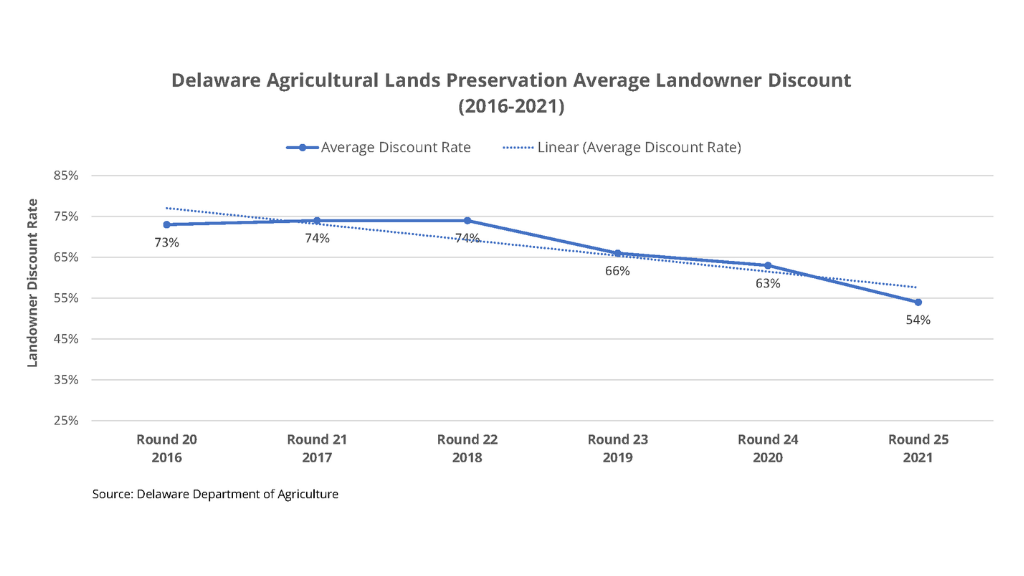DOVER, Del. (September 16, 2021) – A steady downward trend over the past five years in the landowner discounts of permanent agricultural conservation easements selected for purchase in Delaware shows it’s a great time for landowners to preserve their farms.
The Delaware Agricultural Lands Preservation Foundation is accepting agricultural preservation district applications through October 31 from landowners who want to preserve their farms. These landowners will have the opportunity to apply for Round 26 in 2022. Before the landowner can submit a bid to sell an easement, the farm must be enrolled in a preservation district.
“For anyone who hesitated to enroll their farm or submit a bid because of high discounts, this is a great time to participate in our program,” said Secretary of Agriculture Michael T. Scuse. “The Aglands Preservation program received $10 million for the current fiscal year, and we anticipate receiving significant federal funding from USDA-NRCS. We also plan to continue working with all three counties to preserve farms they are interested in protecting.”
Since the program began in 1996, Delaware has preserved more than 1,100 farms with more than 143,000 acres and has over 180,000 acres of land enrolled in farmland preservation districts.
According to Aglands Program Administrator Jimmy Kroon, “Increased funding for Aglands Preservation in recent years has reduced the competition during our annual selection process for permanent preservation. The average discount has steadily decreased from 74 percent in 2018 to 54 percent in 2021, and over the last three years, 90 percent of bids to sell a permanent easement have been accepted.”
 The Delaware Agricultural Lands Preservation Foundation selects those farms approved for easement purchase using an impartial discounted ranking system that maximizes benefits for taxpayers. The Foundation does not own the land but instead purchases landowners’ development rights and places a permanent agricultural conservation easement on the property. Landowners must first voluntarily enroll their farm into a 10-year preservation district before they can sell an easement.
The Delaware Agricultural Lands Preservation Foundation selects those farms approved for easement purchase using an impartial discounted ranking system that maximizes benefits for taxpayers. The Foundation does not own the land but instead purchases landowners’ development rights and places a permanent agricultural conservation easement on the property. Landowners must first voluntarily enroll their farm into a 10-year preservation district before they can sell an easement.
Delaware farmers interested in preserving their farms should be sure they meet the following eligibility requirements:
• Property must be zoned for agriculture and not subject to any major subdivision plan.
• The property meets the minimum Land Evaluation and Site Assessment (LESA) score of 170. LESA is a process that attempts to estimate the farm’s long-term viability based on the farm’s soil productivity and the land use and agriculture infrastructure on and around the farm. Scores range from 0-300. Aglands program staff calculate the LESA score when applications are received.
• The property has to meet the state’s Farmland Assessment Act (10 acres or more which generate at least $1,000 in agricultural sales annually; farms under 10 acres which create at least $10,000 annually in agricultural sales).
• Farms of 200 acres or more constitute an agricultural district.
• Farms under 200 acres can enter the program if they are within 3 miles of an existing agricultural district. With over 1,100 farms already preserved, it is rare that a farm under 200 acres does not meet these criteria.
Entirely forested properties in managed timber production can also enroll in the Forestland Preservation Program, which purchases Forestland Preservation Easements through a similar process as Aglands Preservation. The Delaware Agricultural Preservation Foundation may spend up to $1 million of the $10 million appropriation on Forestland Preservation easements.
Landowners interested in preserving their farm can find information and application forms online at https://agriculture.delaware.gov/agland-preservation-planning/ or contact the Aglands Preservation Program at 302-698-4530.
The Delaware Agricultural Lands Preservation Foundation’s Board of Trustees includes representatives from agriculture and state agencies. Trustees are Mark Collins, chairman; James G. Vanderwende, vice-chairman; Janice Truitt, treasurer; William H. “Chip” Narvel Jr., secretary; Secretary of Agriculture Michael T. Scuse; State Treasurer Colleen C. Davis; Secretary of Natural Resources and Environmental Control Shawn Garvin; Peter Martin; Theodore P. Bobola Jr.; Robert Emerson; and H. Grier Stayton.
###